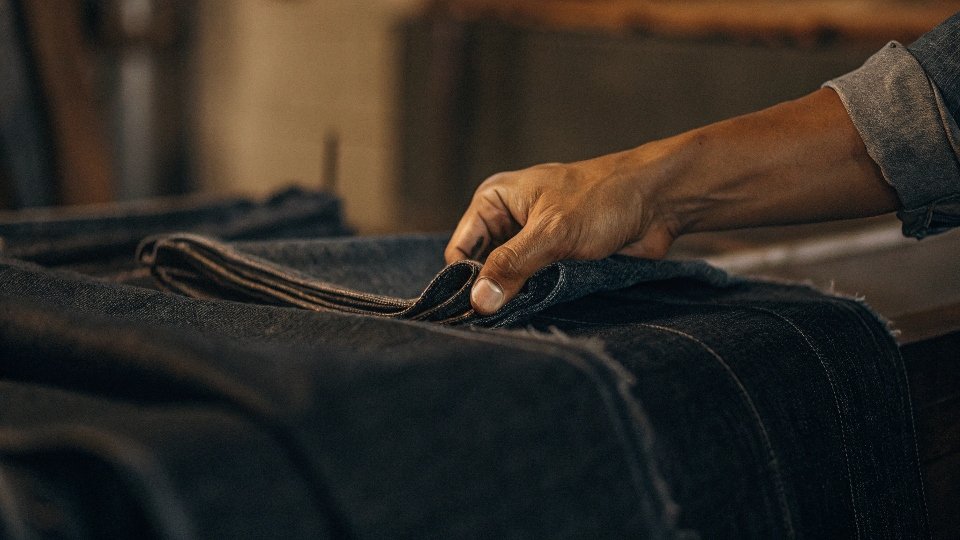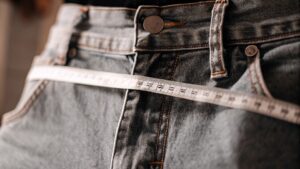You're standing in a store, holding two pairs of jeans. They look almost identical, but one is a fraction of the price of the other. You know the fabric is the key, but how can you really tell?
To check jean fabric quality, use your senses. Look for a dense, even weave with a clear diagonal texture. Feel for substance and weight. Good denim should smell clean, not of harsh chemicals. Finally, check the label for a high cotton content.

After twenty years of handling denim every single day, I can tell the quality of a fabric in seconds. A client like Dean, who designs high-end jeans, has this same instinct. It's a skill you develop from experience. But it isn't magic. It's a checklist of specific things to look for, feel for, and even smell for.
When I walk through a store, I can pick up a pair of cheap jeans and know exactly why they are cheap, just by the feel of the cloth. I'm going to break down that process for you, so you can learn to see a fabric like a pro.
How Can You Identify Jean Fabric Quality by Sight and Smell?
That pair of jeans looked perfect online, but when it arrived, it had a weird chemical smell1. Is this just something that will wash out, or is it a sign of a deeper problem?
A strong chemical or sour odor2 is a major red flag, indicating cheap dyes or poor finishing processes. Visually, high-quality denim has a uniform color, a clean surface, and a clear, distinct diagonal twill weave without blemishes.

Before you even touch the fabric, your nose and eyes can tell you a lot. Your insight about smell is the first and most important test. In my factory, we work hard to ensure our finishing processes are clean. If you open a package and get hit with a sharp, sour, or chemical smell, it's a sign of low-quality agents or improper washing. It means corners were cut to save money. More importantly, those chemicals can be harsh on your skin. Good denim should smell neutral and clean, maybe with a faint, earthy scent of cotton.
Next, use your eyes. Look closely at the surface. You're looking for a clean, consistent color and a very clear diagonal line in the weave. This is the "twill" that defines denim. On a good fabric, those diagonal lines are crisp and easy to see. Now, flip it over and look at the inside. The horizontal (weft) threads should be uniform and clean, with no little black specks or random fuzzy bits woven in. These impurities are a sign of low-grade cotton and sloppy production.
Is 70% Cotton in Denim a Good Thing?
You see a pair of jeans labeled "70% Cotton, 28% Polyester, 2% Spandex." They feel incredibly comfortable, but you can't help but wonder if you're giving up the quality and durability of real denim.
A 70% cotton blend is good for achieving a specific goal: high stretch and comfort. It is not, however, traditional denim. You gain instant comfort but sacrifice the durability and unique fading character of 100% cotton jeans.

This is a question of purpose, not just quality. In my business, we produce all kinds of fabrics to meet a designer's vision. A 70% cotton blend has its place. Polyester is added for strength and to help the garment keep its shape and color. Spandex (or Lycra, or elastane) provides the stretch that is essential for modern skinny-fit jeans. These blends make for very comfortable, easy-to-wear pants right off the rack.
However, for a denim purist, this is a major compromise. The beauty of traditional denim lies in its 100% cotton composition. The cotton breathes well, is incredibly durable, and most importantly, it breaks in over time. The fabric sets creases based on your body and movement, leading to those beautiful, personal fades.
A stretch blend, by its nature, wants to snap back into shape. It won't hold a sharp crease, so the fades will be softer and less defined. A 70% cotton blend3 is perfect for a trendy, comfortable fashion item, but for a classic, long-lasting pair of jeans that will tell a story, you need to look for a much higher cotton content, preferably 100%.
| Feature | 100% Cotton Denim | 70% Cotton Blend Denim |
|---|---|---|
| Comfort | Stiff at first, softens with wear | Instantly soft and comfortable |
| Durability | Very high | Moderate |
| Fading Potential | High-contrast, sharp fades | Softer, less defined fades |
| Best For | Heritage styles, long-term wear | Skinny fits, fashion, comfort |
How Can You Judge Denim Quality by Touch?
You're feeling a pair of jeans that are as soft as a t-shirt. Your first thought is "this must be high quality." But then you remember some very cheap jeans you've owned also felt soft.
Judge quality by feeling for substance and density, not just softness. High-quality denim has a solid weight and a dense, tight weave. Squeeze the fabric; it should feel substantial, not thin and flimsy. Softness can be added chemically.

Your insight on this is absolutely correct: softness can be a trap. In my wash house, I have access to a whole range of softeners and silicone treatments. We can take a mediocre fabric and make it feel incredibly soft to the touch. This is a common tactic to make lower-grade jeans seem more luxurious than they are.
Instead of focusing on softness, focus on what I call "guts." Pick up the fabric and feel its weight. Does it feel solid and substantial, or light and flimsy? Generally, heavier denim (measured in ounces) is more durable. Then, pinch a piece of the fabric between your thumb and forefinger and rub them together. Does it feel dense and tightly woven, or does it feel loose and thin? A tight, dense weave means more cotton is packed into every square inch, which translates directly to better strength and durability.
You should also be able to feel the texture of the diagonal twill lines. A quality fabric has a noticeable texture, while a cheap one often feels flat and characterless. Remember, a good pair of jeans often starts a bit stiff and earns its softness through wear.
How Do You Know If Jeans Are Made From Real, Quality Denim?
You're ready to invest in a great pair of jeans, but you feel overwhelmed. Labels, stitching, fabric feel4... how can you put all the clues together to confidently decide "This is a quality garment"?
To confirm real quality, you need to be a detective. Check the label for a high cotton content. Inspect the stitching for clean, even lines. Feel the fabric's density. A reputable manufacturer5 that uses great fabric won't hide this information.

This is where you bring all the steps together to form a final judgment. It's a holistic process.
First, as your insight states, look at the tags and labels. A brand that is proud of its product will tell you what it's made of. Look for a clear declaration of the fiber content and country of origin. Transparency is a sign of confidence and quality.
Second, look beyond the fabric to the overall construction. A factory that invests in premium denim6 is not going to use cheap thread or sloppy sewing. Inspect the seams. Are the stitches neat, tight, and even? Are there any loose threads or skipped stitches? Check the belt loops and pocket corners—these are high-stress areas. Strong, clean workmanship indicates a high standard for the entire garment, starting with the fabric.
Finally, while you can't perform lab tests for tear strength and colorfastness yourself, you can trust the reputation of the maker. A manufacturer known for quality is performing these professional tests behind the scenes. By combining your own sensory checks—smell, sight, and touch—with an inspection of the labels and construction, you can be very confident in your ability to separate the real deal from the imposters.
Conclusion
By learning to use your eyes, hands, and even your nose, you can cut through the marketing and assess the true quality of a fabric, ensuring your next pair of jeans is a worthy investment.
-
A chemical smell can signal poor quality and harmful chemicals, which is important to avoid. ↩
-
A sour odor can indicate poor quality and should be avoided when purchasing jeans. ↩
-
A 70% cotton blend offers comfort but may compromise durability; understanding this helps in decision-making. ↩
-
The feel of the fabric can reveal its quality, helping you avoid low-grade options. ↩
-
Knowing how to identify reputable manufacturers helps ensure you buy quality jeans. ↩
-
Understanding premium denim helps you make informed choices for high-quality jeans. ↩






